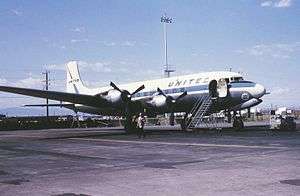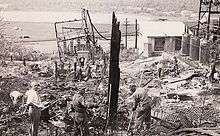United Airlines Flight 624
 A DC-6 similar to the aircraft involved in the accident | |
| Accident summary | |
|---|---|
| Date | June 17, 1948 |
| Summary | In-flight fire (false warning) followed by crew incapacitation |
| Site | Conyngham Township, Columbia County, near Aristes, Pennsylvania |
| Passengers | 39 |
| Crew | 4 |
| Fatalities | 43 (all) |
| Injuries (non-fatal) | 0 |
| Survivors | 0 |
| Aircraft type | Douglas DC-6 |
| Aircraft name | Mainliner Utah |
| Operator | United Airlines |
| Registration | NC37506 |
| Flight origin | Lindbergh Field, San Diego |
| 1st stopover | Los Angeles Airport |
| Last stopover | Chicago Municipal Airport |
| Destination | LaGuardia Airport, New York City |
United Airlines Flight 624, a Douglas DC-6 airliner, registration NC37506, was a scheduled passenger flight that originated in San Diego, California with stops in Los Angeles and Chicago en route to LaGuardia Airport in New York City. The four-engine propeller-driven airplane crashed at 1:41 p.m. Eastern Daylight Time on June 17, 1948 outside of Aristes, Pennsylvania, killing all 4 crew members and 39 passengers on board.[1]
Background
The Douglas DC-6 fleet had been grounded by Civil Aviation authorities for four months during the previous winter as a result of the fatal crash of United Airlines Flight 608 on October 24, 1947. It was determined that the crash had been caused by a design flaw that allowed vented fuel to be drawn into the heater air intake scoop that caused a fire in the cargo compartment. As a result, changes were made and a fire extinguisher system was installed on all DC-6 aircraft, including the accident aircraft.
Accident sequence
Flight 624 from San Diego had just completed a routine initial descent as part of its approach into the New York area, when the forward cargo hold fire indicator light illuminated, leading the flight crew to believe there was a fire in that cargo hold. Although this later turned out to be a false alarm, the crew decided to discharge CO2 bottles into the forward cargo hold, to try to extinguish the possible fire.
While proper operating procedure called for opening the cabin pressure relief valves prior to discharging the CO2 bottles, to allow for venting of the CO2 gas buildup in the cabin and cockpit, there was no evidence the crew opened the relief valves. Consequently, the released CO2 gas seeped back into the cockpit from the front cargo hold and apparently partially incapacitated the flight crew. The crew then put the aircraft into an emergency descent, and as it descended lower it hit a high voltage power line, bursting into flames, then smashing through the trees of a wooded hillside.[1]
Ed Darlington of radio station WCNR at nearby Bloomsburg said "there was no sign of life and apparently everyone was killed." The scene of the wreck was in a sparsely wooded area about five miles from Mt. Carmel, a small town 135 miles from Philadelphia where delegates are gathering for the Republican National Convention. News of the crash brought excited whispering from the delegates. No one knew for certain whether any high Republican officials were on the plane.
Ira F. Roadarmel of Mt. Carmel, one of the first persons on the scene, said "everything was scattered. The largest piece of the plane left was an engine. The rest of the plane was in small parts — so small they could be carried."
George Minnich, an employee of Midvalley Colliery No. 2, which the plane missed by only 100 yards in its descent, said that he saw the plane bank. "Suddenly there was a horrible crash," he said. "All you could see was a mass of flames. It sounded as though the end of the world was coming."[2]
The plane's logbook, found near the scene of the crash in a thickly wooded area, identified the plane's pilot as Captain George Warner.
— The Sheboygan Press, June 17, 1948.

Notable victims
Among the passengers were Broadway theatre impresario Earl Carroll and his girlfriend, actress Beryl Wallace; Henry L. Jackson, men's fashion editor of Collier's Weekly magazine and co-founder of Esquire Magazine; and Venita Varden Oakie, the former wife of actor Jack Oakie.[3]
An interesting item discovered in the wreckage was a script of Garry Moore's Take It or Leave It show broadcast at the time each Sunday night over NBC, but an NBC spokesman in New York said he was "certain" Moore was not on the plane.
Investigation and final report
The Civil Aeronautics Board investigated the crash and published a narrative describing the following sequence of events in its final report:[1]
The airplane, named Mainliner Utah, arrived in Chicago at 09:52 en route from Los Angeles to New York. After a 52-minute turnaround, the DC-6 departed for New York. The airplane climbed en route to its planned altitude of 17,000 feet. At 12:23, and at 12:27 the crew made a routine acknowledgment of a clearance to descend en route to an altitude between 13,000 and 11,000 feet. A little later a fire warning led the crew to believe that a fire had erupted in the forward cargo hold. They then discharged at least one bank of the CO2 fire extinguisher bottles in the forward cargo hold. Because they did not follow the correct procedure, the cabin pressure relief valves were closed. This caused hazardous concentrations of the gas to enter into the cockpit. These concentrations reduced the pilots to a state of confused consciousness probably resulting in loss of consciousness. An emergency descent was initiated until it described a shallow left turn, heading towards constantly rising terrain. Five miles east of Shamokin the airplane, flying only 200 feet above the ground, entered a right climbing turn. As it passed to the north of Mt. Carmel, the climbing turning attitude increased sharply. The airplane then crashed in a power line clearing on wooded hillside at an elevation of 1,649 feet. The airplane struck a 66,000 volt transformer, severed power lines and burst into flames.Investigation revealed that the fire warning in the cargo compartment had been false.
— CAB File No. 1-0075-48
The CAB concluded with the following probable cause for the accident: "The Board determines that the probable cause of this accident was the incapacitation of the crew by a concentration of CO2 gas in the cockpit."
Flight Number
United now uses the 624 designation to refer to a Denver-Omaha-Chicago-DC (National) route.[4]
See also
- Centralia, Pennsylvania
- List of accidents and incidents involving commercial aircraft
- TWA Flight 513
- United Airlines Flight 608
- "United 624 Crash in Wilburton, PA June 17, 1948". Anthracite Coal Region. Retrieved 2016-08-08.
References
- 1 2 3 Accident description at the Aviation Safety Network
- ↑ "Major Airline Disasters: Involving Commercial Passenger Airlines 1920-2011". http://www.airdisasters.co.uk. Retrieved 22 February 2013. External link in
|work=(help) - ↑ Johnson, Deryl B (2004). Centralia; Images of America. Charleston, SC: Arcadia Publishing. p. 12. ISBN 978-0-7385-3629-3.
- ↑ "Flight Status for UA 624". Retrieved 2008-03-06.
Coordinates: 40°49′14″N 76°21′40″W / 40.820427°N 76.361042°W